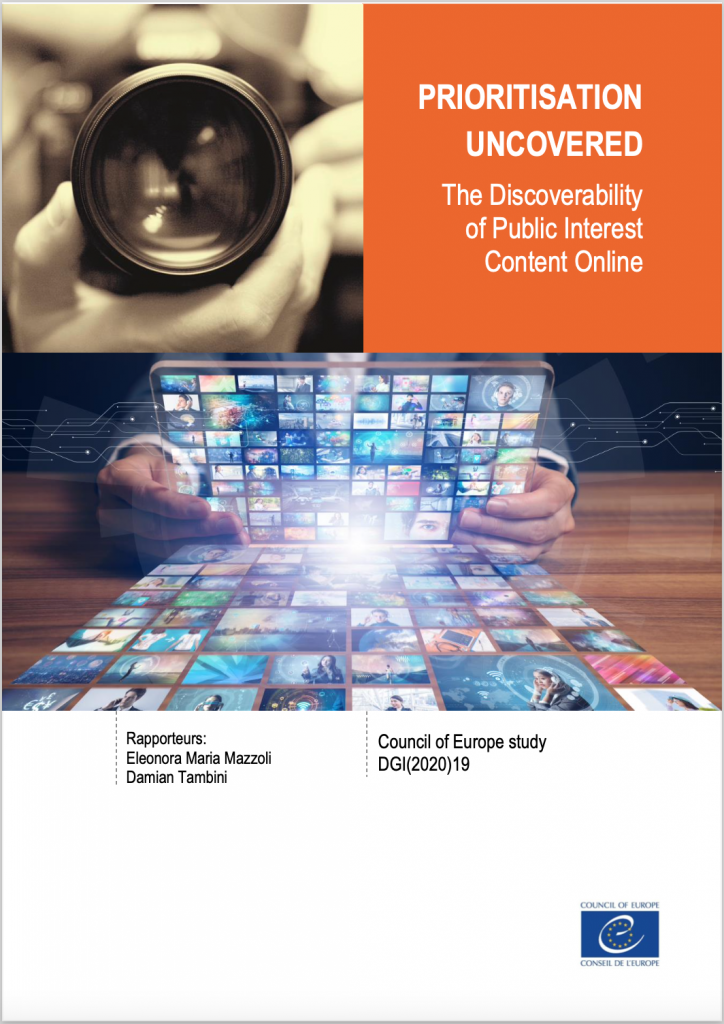 A new Council of Europe report on “Prioritisation Uncovered: the discoverability of public interest content online” – by the LSE’s PhD researcher Eleonora Maria Mazzoli and Distinguished Policy Fellow Damian Tambini – raises some provocative and timely questions: How is the control over a user’s journey to content shifting? Who has the power to decide what should be prioritised, and what content should be of the public interest? What are the strategies and criteria used by different organisations to make these decisions? At a time of increased online disinformation and manipulation, these concerns are becoming more urgent for public policymakers and society as a whole.
A new Council of Europe report on “Prioritisation Uncovered: the discoverability of public interest content online” – by the LSE’s PhD researcher Eleonora Maria Mazzoli and Distinguished Policy Fellow Damian Tambini – raises some provocative and timely questions: How is the control over a user’s journey to content shifting? Who has the power to decide what should be prioritised, and what content should be of the public interest? What are the strategies and criteria used by different organisations to make these decisions? At a time of increased online disinformation and manipulation, these concerns are becoming more urgent for public policymakers and society as a whole.
This new report highlights how, as media consumption shifts onto a range of on-demand, mobile, social and streaming services, the role of content curation processes such as prioritisation, prominence and discoverability becomes pivotal in nudging audiences’ choices and ultimately driving access to and consumption of content.
Questions about the public interest in these processes – about which content or content providers should be easier to discover, while others are made less visible or moderated away – are now key issues in the content distribution strategies of media and tech companies.
These questions have always been part of media and communication regulatory debates. In the traditional TV world, they have been addressed through broadcasting regulation such as national rules on Electronic Programme Guides (EPGs), content quotas and prominence provisions in the European Audiovisual Media Services Directive (AVMSD); and through telecoms regulation, with must-carry and must-offer obligations on telecommunication providers. However, nowadays the issue of whether regulators or governments should create regimes of prominence online, or rather step back from the ongoing process of an ad-hoc private construction of prioritisation regimes, raises complex questions at the intersection of freedom of expression, media freedom and media pluralism.
These debates are currently being addressed both at a European level, in the framework of the European Digital Services Acts and the Digital Market Acts, as well as in different national contexts, including in the UK with Ofcom’s revision of the EPG Prominence Rules, and in Germany with the rather far-fetched proposals of the new Inter-State Media Treaty (Medienstaatsvertrag).
 However, as media technologies advance it becomes harder to strike the right balance between different interests and objectives, and among policy makers there remains a lack of understanding of industry practices combined with a broader a lack of transparency from tech and media companies around how content is made more or less discoverable on different interfaces and services. Thus, with this study we aimed to fill this gap and to provide a common vocabulary and an analytical framework to shed clarity over the range of new, commercial, non-commercial and public-interest driven prioritisation practices that are in operation in today’s media systems.
However, as media technologies advance it becomes harder to strike the right balance between different interests and objectives, and among policy makers there remains a lack of understanding of industry practices combined with a broader a lack of transparency from tech and media companies around how content is made more or less discoverable on different interfaces and services. Thus, with this study we aimed to fill this gap and to provide a common vocabulary and an analytical framework to shed clarity over the range of new, commercial, non-commercial and public-interest driven prioritisation practices that are in operation in today’s media systems.
By content prioritisation processes, we refer to the range of design and algorithmic decisions of media and technology companies that can result in the prioritised placement of a channel/app/service compared to others in time, and/or space on a given interface (i.e. prominence), that is in turn linked to the likelihood of discovery of and consumption of such channel/app/service by the final users (i.e. discoverability).
These decisions are not outcomes of neutral technological services, nor they happen in a vacuum. On the contrary, they are often the results of contested negotiation processes and power dynamics between different actors involved in the audiovisual media value chain. In practice, the report therefore discusses how media and technology companies promote content through different strategies and means, from EPGs, personalised recommendations, ranking systems, search results display, newsfeed and other algorithmic processes.
Certainly, there are differences in the processes and mechanisms, depending on the type of technology and services that we are addressing, but we have also identified common influence factors that come into play. Such influence factors include – but are not limited to – regulatory pressures, technological architecture of hardware and software systems, the level of users’ agency and literacy, and the commercial negotiations between different organisations, or in other words, the platform-to-business relations.
These dynamics inevitably have implications for the future of our online media systems. Given the crucial role of the Council of Europe in the protection of democracy, the rule of law and the fundamental rights, we highlighted key emerging issues that are relevant for these areas, which include:
- Impacts of content prioritisation processes on users’ diversity of exposure, which is the extent to which audiences are exposed to, and therefore find, discover and consume a diverse array of content and sources.
- Potential reinforcement of existing structural and systemic inequalities when behavioural nudges and automated systems of prioritisation are combined with potential ethnic, gender, social, and racial biases.
- An unequal bargaining power in negotiations around prominence which can also exacerbate the decline of local and national providers and their economic sustainability.
- Worrisome implications that private or state-driven soft forms censorship and propaganda might have on media freedom and democracy, which prompts us to reflect on who has (and who should have) the power to decide what content is prioritised to whom.
So, how fit-for-purpose are our regulatory systems to cater for these issues? In its concluding remarks, this study argues that there is an interest and a need to reconsider existing regulatory frameworks to cater for the ongoing changes in the media landscape. While there is no one-size-fits-all solution, the proposed recommendations prompt member states to reflect on what approach might be more suitable, whether procedural regulation, self-regulation or more structural interventions. A balance should be reached, potentially envisioned through a combination of multiple legal instruments and different levels of policy interventions, such as a combination of minimum legal, operational and technical standards over content curation processes, with regulatory obligations, transparency requirements and voluntary incentives to promote exposure while respecting consumers’ freedom of choice.
Furthermore, we suggest targeted media literacy initiatives to increase users’ awareness, combined with complementary sector-specific interventions to promote media independence, including ownership and competition rules. Overall, however, regulators and policymakers should seek to introduce incentives to maintain not only obligations to provide prominence for public interest content, but also transparent and procedurally fair and open processes based on consent and periodic reviews. They must also be open to input from civil society and should establish criteria for process-based rather than content-based standards of the public interest.
Eleonora presented the report’s findings during a recent session of the IPPR Virtual Oxford Media Convention, which is available to watch here. This report has been heavily informed by Eleonora’s PhD project on content curation and discoverability practices of digital intermediary services, which is funded by the Doctoral Training Partnership of the UK Economic and Social Science Research Council (ESRC).
This article represents the views of the author and not the position of the Media@LSE blog, nor of the London School of Economics and Political Science.





